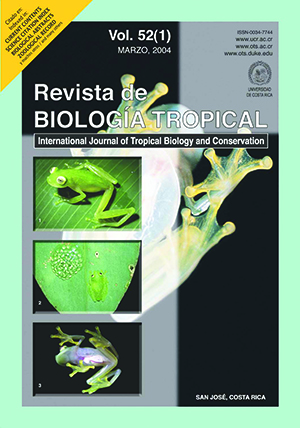Resumen
Se describe una nueva especie del género Dipsas de las montañas Pakaraima de Guyana. Esta se caracteriza por presentar 15 hileras de escamas dorsales con las esca- mas de la hilera vertebral ligeramente agrandadas, cuatro pares de escudos geneiales con el primer par elongado, loreal elongado y en contacto con la órbita, una escama preocular, seis labiales superiores y la cabeza angosta en la partie anterior y más ancha posteriormente. No se determino su ubicación de acuerdo a los grupos de especies de Peters (1960). La nueva especie solo es cono- cida a 1490 m.s.n.m. en el monte Ayanganna, un tepuy del Escudo Guayanés, en bosque de baja altura, dentro de bromelias o sobre ramas. Es el primer informe del género Dipsas como miembro de la fauna altotepuyana del Escudo Guayanés.Citas
Chippaux, J.–P. 1986. Les serpents de la Guyane française. ORSTOM Faune Tropical #27, Paris. 165 p.
Donnelly, M.A. & C.W. Myers. 1991. Herpetological results of the 1990 Venezuelan expedition to the summit of Cerro Guaiquinima, with new tepui reptiles. Amer. Mus. Novit. 3017: 1–54.
Dowling, H.G. 1951. A proposed method of expressing scale reductions in snakes. Copeia 1951(2):
–134.
Dowling, H.G. & J.M. Savage. 1960. A guide to the snake hemipenis: a survey of basic structure and systemat-
ic characteristics. Zoologica 45: 17–28.
Fanshawe, D.B. 1952. The vegetation of British Guiana: a preliminary review. Inst. Paper #29, Imperial
Forestry Inst., Oxford. 96 p.
Gorzula, S. & J. Ayarzagüena. “1995” [1996]. Dos nuevas especies del genero Thamnodynastes (Serpentes:
Colubridae) de los tepuyes de la Guayana Venezolana. Publ. Asoc. Amigos de Doñana 6: 1–17.
Gorzula, S. & J.C. Señaris. “1998” [1999]. Contribution to the herpetofauna of the Venezuelan Guayana I. A data base. Scientia Guaianae #8, Caracas. xviii + 270 + 32 p.
Huber, O., G. Gharbarran & V. Funk. 1995. Vegetation map of Guyana. Centre for the Study of Biological Diversity, Univ. of Guyana, Georgetown.
Kofron, C.P. 1982. A review of the Mexican snail-eating snakes, Dipsas brevifacies and Dipsas gaigae. J. Herpetol. 16: 270–286.
Kornacker, P.M. 1999. Checklist and key to the snakes of Venezuela. Pako-Verlag, Rheinbach. 269 p.
MacCulloch, R.D. & A. Lathrop. 2001. A new species of Arthrosaura (Sauria: Teiidae) from the highlands of
Guyana. Carib. J. Sci. 37: 174–181.
MacCulloch, R.D. & A. Lathrop. 2002. Exceptional diversity of Stefania (Anura: Hylidae) on Mount Ayanganna, Guyana: three new species and new distribution records. Herpetologica 58: 327–346.
Maguire, B. 1970. On the flora of the Guyana highland.Biotropica 2: 85-100.
Myers, C.W. 1997. Preliminary remarks on the summit herpetofauna of Auyantepui, eastern Venezuela. Acta
Terramaris 10: 1–8.
Myers, C.W. & M.A. Donnelly. 1996. A new herpetofauna from Cerro Yavi, Venezuela: first results of the Robert G. Goelet American Museum – Terramar expedition to the northwest tepuis. Amer. Mus. Novit. 3172: 1–56.
Myers, C.W. & M.A. Donnelly. 1997. A tepui herpetofauna on a granitic mountain (Tamacuari) in the border land between Venezuela and Brazil: report from the Phipps Tapirapeco expedition. Amer. Mus. Novit. 3213: 1–71.
Myers, C.W. & M.A. Donnelly. 2001. Herpetofauna of the Yutaje-Corocoro massif, Venezuela: second report
from the Robert G. Goelet American Museum Terramar expedition to the northwestern tepuis. Bull. Amer. Mus. Nat. Hist. 261: 1–85.
Peters, J.A. 1956. An analysis of variation in a South American snake, Catesby’s snail-sucker (Dipsas catesbyi Sentzen). Amer. Mus. Novit. 1783: 1-41.
Peters, J.A. 1960. The snakes of the subfamily Dipsadinae. Misc. Pub. Mus. Zool. Univ. Michigan 114: 1–224.
Peters, J.A. & B. Orejas-Miranda. 1970. Catalogue of the neotropical squamata. Part I. Snakes. U.S. Nat. Mus.
Bull. 297: 1–347.
Reynolds, R.P. & M.S. Foster. 1992. Four new species of frogs and one new species of snake from the Chapare
region of Bolivia, with notes on other species. Herpetol. Monogr. 6: 83–104.
Roze, J.A. 1958a. Los reptiles del Auyantepui, Venezuela, basandose en las colecciones de las
expediciónes de Phelps-Tate, del American Museum of Natural History, 1937-1938, y de la Universidad Central de Venezuela, 1956. Acta Biol. Venez. 2: 243–270.
Roze, J.A. 1958b. Los reptiles de Chimanta tepui (Estado Bolivar) Venezuela, colectados por la expedición
botanica del Chicago Natural History Museum. Acta Biol. Venez. 2: 299–314.
Roze, J.A. 1966. La taxonomía y zoogeografía de los ofidios de Venezuela. Univ. Central de Venezuela,
Caracas. 362 p.
Savage, J.M. 2002. The Amphibians and Retiles of Costa Rica: a herpetofauna between two continents, between two seas. University of Chicago. pp. 596- 599.
Starace, F. 1998. Guide des serpents et amphisbènes de Guyane. Ibis Rouge, Paris. 449 p.
##plugins.facebook.comentarios##

Esta obra está bajo una licencia internacional Creative Commons Atribución 4.0.
Derechos de autor 2004 Revista de Biología Tropical


